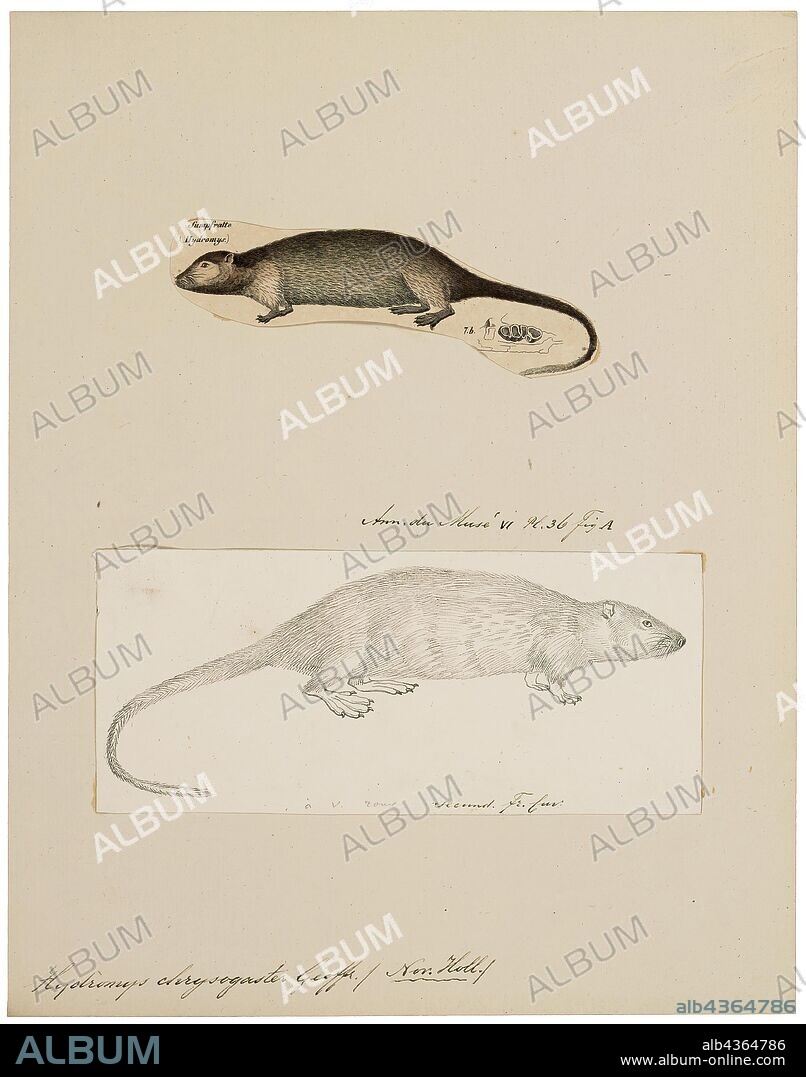alb4364786
Hydromys chrysogaster, Print, The rakali, Hydromys chrysogaster, also known as the rabe or water-rat, is an Australian native rodent first described in 1804. The change to the aboriginal name Rakali was intended to foster a positive public attitude by Environment Australia. It is the only member of the genus Hydromys with a range extending beyond Papua New Guinea and Indonesian West Papua. Having adapted to and colonised a unique niche of a semiaquatic and nocturnal lifestyle, this species lives in burrows on the banks of rivers, lakes and estuaries and feeds on aquatic insects, fish, crustaceans, mussels, snails, frogs, birds' eggs and water birds. Rakali have a body 231–370 millimetres (9.1–14.6 in) in length, weigh, 340–1, 275 grams (0.750–2.811 lb) and have a thick tail measuring around 242–345 millimetres (9.5–13.6 in). Females are generally smaller than males but tail lengths are normally the same.They have partially webbed hind legs, waterproof fur, a flattened head, a long blunt nose, many whiskers and small ears and eyes. The body is streamlined with a skull that is large, flat and elongated, with two molars on the upper and lower jaw, similar to the False water rat Xeromys myoides. They are black to brown in colour with an orange to white belly, and dark tail with a white tip., 1700-1880.

|
Zu einem anderen Lightbox hinzufügen |
|
Zu einem anderen Lightbox hinzufügen |



Haben Sie bereits ein Konto? Anmelden
Sie haben kein Konto? Registrieren
Dieses Bild kaufen
Untertitel:
Siehe automatische Übersetzung
Hydromys chrysogaster, Print, The rakali, Hydromys chrysogaster, also known as the rabe or water-rat, is an Australian native rodent first described in 1804. The change to the aboriginal name Rakali was intended to foster a positive public attitude by Environment Australia. It is the only member of the genus Hydromys with a range extending beyond Papua New Guinea and Indonesian West Papua. Having adapted to and colonised a unique niche of a semiaquatic and nocturnal lifestyle, this species lives in burrows on the banks of rivers, lakes and estuaries and feeds on aquatic insects, fish, crustaceans, mussels, snails, frogs, birds' eggs and water birds. Rakali have a body 231–370 millimetres (9.1–14.6 in) in length, weigh, 340–1, 275 grams (0.750–2.811 lb) and have a thick tail measuring around 242–345 millimetres (9.5–13.6 in). Females are generally smaller than males but tail lengths are normally the same.They have partially webbed hind legs, waterproof fur, a flattened head, a long blunt nose, many whiskers and small ears and eyes. The body is streamlined with a skull that is large, flat and elongated, with two molars on the upper and lower jaw, similar to the False water rat Xeromys myoides. They are black to brown in colour with an orange to white belly, and dark tail with a white tip., 1700-1880
Bildnachweis:
Album / quintlox
Freigaben (Releases):
Model: Nein - Eigentum: Nein
Rechtefragen?
Rechtefragen?
Bildgröße:
4187 x 5321 px | 63.7 MB
Druckgröße:
35.4 x 45.1 cm | 14.0 x 17.7 in (300 dpi)
Schlüsselwörter:
ABDRUCK • ANATOMIE: SCHAEDEL • APFELSINE • AUGE • AUGE, SEHEN • AUGEN • BLACK • BRAUN • BRÜNETT • CRANIUM • FARBE • FARBIG • FISCH • FISCHE • FISCHE, ALLE • FISCHE, VIELE • FLUSS • FRAU • FRAUEN • GEWICHT • HERREN • KADAVER • KOERPER • KORPER • KÖRPER • LEICHE • MAENNER • ORANGE • SCHAEDEL • SCHAEDEL, ANATOMIE • SCHWARZ • SCHÄDEL • SEE • TOTENKOPF • UNTERKIEFER • WEIBCHEN • WOMAN
 Pinterest
Pinterest Twitter
Twitter Facebook
Facebook Link kopieren
Link kopieren Email
Email
